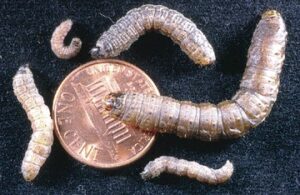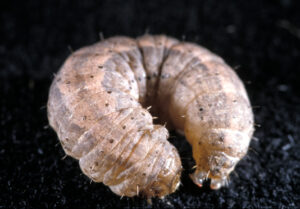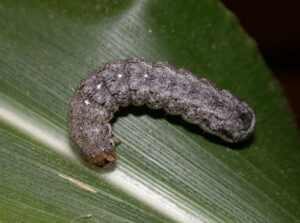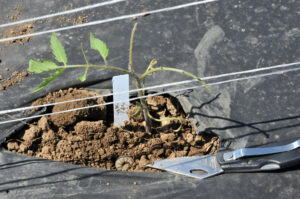Each year we get several reports of seedlings being cut at or near the base of the plant/soil surface. The critter who gets the blame most often is cutworms. And that makes sense because the damage is in the name. However, with closer inspection, it seems that the blame can often be misplaced. There are other organisms, many of which have a backbone, that may be the culprit. Here we will review cutworm identification and discuss other possible causes for cut seedlings.
Cutworm diversity and biology
The black cutworm (Figure 1) is our most commonly found species in field crops In Indiana, but we also have dingy, claybacked, and variegated cutworms.
So, how do you tell the difference, and does it really matter? Timing and the type of damage caused can give clues to the species. Black cutworms do not overwinter in the Midwest. We monitor their arrival every spring with pheromone traps. Once they arrive in large numbers (intensive captures), we begin predicting their development and subsequent damage with heat unit accumulations. To stay up to date on black cutworm trapping information, subscribe to the Purdue Extension Entomology Pest & Crop Newsletter. While trap catches are high as of late, there have not been enough heat units accumulated this spring for black cutworms to get 1/2 to 3/4 inches long, that being the size where they cut plants.
The other three species of cutworms that can be found in Indiana include the dingy (Figure 2), claybacked (Figure 3), and variegated (Figure 4). The dingy cutworm, probably the second most common species, is primarily a leaf feeder and will rarely cut plants, and if it does, the cutting is above the ground. The dingy and claybacked cutworms overwinter as partially grown larvae. Therefore finding cutworms 3/4 of an inch or more at this time would likely point to these species. Given that many of the reports we receive on potential cutworm damage occur in high tunnels, there is always the possibility that some of the other species may be overwintering in that habitat or that their development could be accelerated because of increased heat units. High tunnels always make things a bit messy when it comes to pest biology!
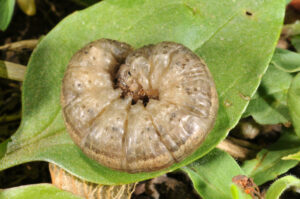
Figure 3. Claybacked cutworm larva curled in the identifiable ‘C’” shape on a leaf (Photo by John Obermeyer).
Cutworms are generalist feeders that readily eat a wide range of vegetable and fruit crops (Figures 5-6). Species like the black cutworm exhibit the characteristic snipping of young plants (seedlings and new transplants) right at the base of the stem where it emerges from the soil, leaving behind seedlings that appear to have been ‘cut down’, thus the name ‘cutworm.’ Most often, if the cut seedling is damaged by cutworms, you will find the top of the plant with herbivore damage near the root/stem. Occasionally cutworms will drag the top down into their burrow and continue to feed, but you should be able to find this under the ground cover if you are scouting often. In addition to early-season stem cutting and defoliation, cutworms can also cause damage later in the season. For example, we have seen cutworms feeding on ripening tomato fruit in high tunnels – an unpleasant discovery!
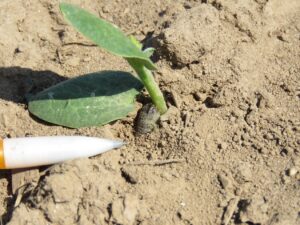
Figure 5. Cutworm larva emerging from the soil to feed on a young pumpkin seedling (Photo by Liz Maynard).
Other potential causes
There are other insects that occur in the soil and feed on dead/decaying plant material. These include beetle grubs (juvenile stage of beetles), crane fly larvae, millipedes, centipedes, worms, and other even smaller invertebrates. If you go digging in the soil, you will likely encounter some of these, which are typically not to blame for troubles with seedling establishment.
Rabbits are on the list of top contenders in my book. They have been detrimental in our high tunnel strawberry production but are too cute to get mad about (Figure 7). They are voracious little critters and will leave a clean-cut stem in their tracks. The plants are usually cut at a 45-degree angle up to about 2.5’ from the ground. Furthermore, when we suspect rabbit damage, there is very consistent plant removal, as if they just eat their way straight down the nicely planted rows.
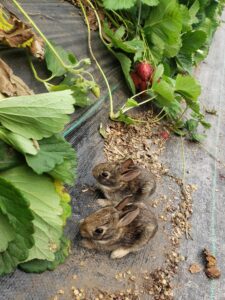
Figure 7. Rabbits munching on the strawberry patch in the high tunnels at Meigs Horticulture Farm (Photo by Laura Ingwell).
Some of a rabbit’s favorite crops include peas, beans, lettuce, and beet leaves. In general, they avoid asparagus, cucurbits, solanaceous crops, corn, onions, and herbs. However, if there is not much available, they can’t be picky. Management can include exclusion, frightening devices like motion-activated sprinklers, repellents, and trapping depending on local laws.
Moles, voles, and mice are the remaining contenders. Mice leave nibble marks here and there, with signs of their feeding left behind in the form of mouse pellets, a contaminant for our produce growers. They don’t usually cause widespread destruction unless they are harvesting nest material. I witnessed this mess when they ate my master’s thesis trees off at the base and piled them into a neat little nest in the middle of the greenhouse. I have not seen reports of this happening with fruit and vegetable plants. Traps and baits are usually effective at controlling this group of pests.
